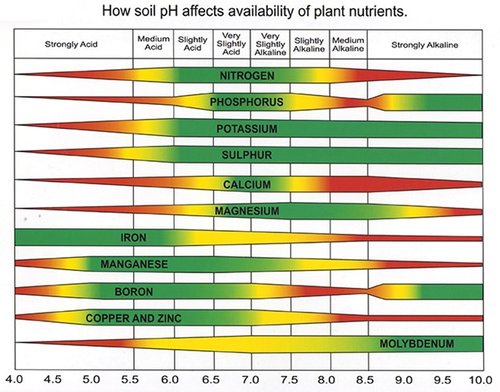Soil Testing Terminology

Percent Hydrogen (pH) – Quantitative measure of the acidity or basicity of aqueous or other liquid solutions. The term is widely used in chemistry, biology, and agronomy, translated the values of the concentration of the hydrogen ion – into numbers between 0 and 14. In pure water, which is neutral (neither acidic nor alkaline). A solution with a pH less than 7 is considered acidic; a solution with a pH greater than 7 is considered basic, or alkaline. Source: Britannica Encyclopedia.
In our area and grass types, the ideal pH range is 6.6-6.9. Soil based nutrients and fertilizer inputs are more widely available when in this range. Source: Luke Zimmerman, Senior Agronomist, Green Image Lawn Care
Cation Exchange Capacity (CEC) – is a measure of how many cations can be retained on soil particle surfaces. Negative charges on the surfaces of soil particles bind positively charged atoms or molecules (cations) but allow these to exchange with other positively charged particles in the surrounding soil water. This is one of the ways that solid materials in soil alter the chemistry of the soil. Source: Wikipedia
Soils with higher CECs can hold on to more nutrients from soil reserves and fertilizer inputs. The higher the CEC, the better able to attract, hold, and maintain nutrient cations within the soil profile for current or future use. A CEC of 8 holds a larger reserve or pool of nutrients than a CEC of 4 for example. Source: Luke Zimmerman, Senior Agronomist, Green Image Lawn Care
Base Cation Saturation Ratio (BCSR) – The BCSR concept, developed by F.E. Bear and colleagues in 1945, supports maintenance of an “ideal” soil having: 65% of cation exchange sites occupied by calcium (Ca) charge, 10% by magnesium (Mg) charge, 5% by potassium (K) charge, and 20% by hydrogen (H) charge. Thirty years later, “The Albrecht Papers” defined the ideal BCSR as (10% H), (10–20% Mg), (2–5% K), (60–75% Ca), (0.5–5% Na), and 5% other cations. In support of plant productivity and health, BCSR embraces balanced availability of base-cation nutrients in soil. Source: Max Schlossberg, PhD, Soil fertility interpretation: base saturation or sufficiency level?
Nitrogen (N) – Component of nucleic acids, amino acids, proteins, chlorophyll, and coenzymes. Affects shoot and root growth, density, color, disease resistance, and stress tolerance. Source: Penn State Extension, Turfgrass Fertilization
Phosphorus (P) – Component of nucleic acids, membranes, adenosine, triphosphate, and several coenzymes. Affects rate of seedling development, maturation, and root growth. Source: Penn State Extension, Turfgrass Fertilization
Potassium (K) – Activates enzymes used in protein, sugar, and starch synthesis. Important in maintaining turgor pressure in plants. Affects drought tolerance, cold hardiness, and disease resistance. Source: Penn State Extension, Turfgrass Fertilization
